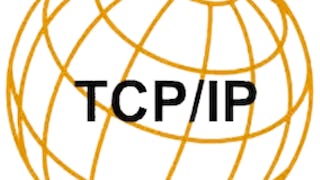Chaque jour, vous utilisez Internet via votre PC (Personal Computer), votre ordinateur portable, votre tablette, votre smartpad et votre smartphone dans tout ce que vous faites. Grâce à votre propre PC/ordinateur portable, vous pouvez facilement apprendre tout ce qui concerne l'Internet, et c'est sur cela que ce cours est axé. Dans ce cours "Introduction à TCP/IP", vous apprendrez les fonctions opérationnelles des technologies Internet (qui comprennent IPv4, IPv6, TCP, UDP, adressage, routage, noms de domaine, etc.) et la sécurité de votre PC/ordinateur portable, la configuration de la passerelle Internet et les principes de base. En outre, grâce à une simple expérience Wireshark, vous verrez les paquets TCP/IP et les systèmes de sécurité en action qui servent votre PC/ordinateur portable, qui vous sert.



(2,783 avis)
Compétences que vous acquerrez
- Catégorie : Réseaux informatiques
- Catégorie : Architecture de réseau
- Catégorie : sécurité des réseaux
- Catégorie : Communication
Détails à connaître

Ajouter à votre profil LinkedIn
9 devoirs
Découvrez comment les employés des entreprises prestigieuses maîtrisent des compétences recherchées


Obtenez un certificat professionnel
Ajoutez cette qualification à votre profil LinkedIn ou à votre CV
Partagez-le sur les réseaux sociaux et dans votre évaluation de performance

Il y a 5 modules dans ce cours
Pour le cours "Introduction à TCP/IP", le premier module est "Internet et passerelle de mon PC", qui présente toutes les fonctions importantes d'Internet que vous utilisez à partir de votre PC (Personal Computer), de votre ordinateur portable ou de votre smartphone. Le premier cours "Configuration Internet de mon PC" explique la configuration utilisée dans votre PC/ordinateur portable. Le cours suivant, intitulé "Configuration automatique d'Internet à l'aide de DHCP", montre comment la connexion Internet de votre PC/ordinateur portable est automatiquement configurée si un serveur DHCP local prend en charge votre réseau. L'accent est ensuite mis sur la configuration de la passerelle par défaut dans les cours intitulés "Configuration de la passerelle IP/du routeur". Comme la passerelle par défaut est la passerelle vers l'Internet pour votre PC/ordinateur portable, le cours "Table de routage IP" montre comment la passerelle par défaut envoie et reçoit tous les paquets pour votre PC/ordinateur portable.
Inclus
5 vidéos2 devoirs1 sujet de discussion
Le deuxième module "Protocole TCP/IP" se concentre sur tous les aspects protocolaires et fonctionnels des opérations TCP et IP utilisées dans votre PC/ordinateur portable/smartphone. Le premier cours "TCP/IP 5 Layers & Operations" fournit une description facile à comprendre de la manière dont TCP/IP fonctionne sur Internet pour transférer des informations, en utilisant un exemple comparable à la manière dont le courrier postal est distribué. Les exposés "IPv4" et "IPv6" décrivent la structure et le fonctionnement des protocoles IPv4 et IPv6. En outre, la notation CIDR (Classless Inter-Domain Routing) ainsi que les adresses IPv4 et IPv6 et les sous-réseaux sont expliqués. Ensuite, les cours sur l'"UDP" et le "TCP" décrivent le fonctionnement du numéro de port et la manière dont le TCP effectue le contrôle de flux et détecte les erreurs dans les paquets que vous avez reçus sur votre PC/ordinateur portable/smartphone.
Inclus
8 vidéos2 devoirs
Le troisième module "Routage et fonctions Internet" se concentre sur les principaux protocoles et fonctions utilisés sur Internet et que vous utilisez tous les jours pour établir des connexions réseau. Le cours "IGP vs. EGP" se concentre sur les types et les fonctions des IGP (Interior Gateway Protocols) et des EGP (Exterior Gateway Protocols). Le cours " OSPF " décrit comment OSPF (Open Shortest Path First) établit des chemins de routage SPT (Shortest Path Tree), ce qui rend vos connexions Internet plus fiables et plus rapides. Les cours "ARP" et "NAT" expliquent comment vous avez utilisé ARP (Address Resolution Protocol) et NAT (Network Address Translation) pour échanger des adresses IP afin d'accéder à des réseaux privés et comment votre PC/ordinateur portable/smartphone a trouvé des adresses IP à partir de noms d'hôtes sur le web. Les exposés "RPC" et "FTP" décrivent comment RPC (Remote Procedure Call) vous a permis d'établir des connexions avec des ordinateurs/serveurs distants, et comment FTP (File Transfer Protocol) vous a aidé à transférer des fichiers d'un ordinateur/serveur distant à votre PC/ordinateur portable aussi rapidement. Le dernier cours, intitulé "E-mail", compare les caractéristiques des protocoles IMAP (Internet Message Access Protocol) et POP3 (Post Office Protocol version 3) et la manière dont ils fonctionnent pour servir tous vos e-mails.
Inclus
2 vidéos2 devoirs
Le module "Sécurité Internet" se concentre sur les types d'attaques Internet les plus populaires et décrit les méthodes utilisées par votre PC/ordinateur portable/smartphone pour prévenir et se défendre contre les cyberattaques. Le premier cours "Top Ranking Internet Attacks" décrit les types d'attaques les plus courants et les classe en fonction du pourcentage d'incidents. Votre PC/ordinateur portable/smartphone a reçu ces attaques à 100 %, vous ne le saviez pas, mais maintenant vous le saurez. Le cours "Sécurité croissante et menaces" traite des ordinateurs zombies, des réseaux de zombies et d'autres techniques d'attaque émergentes susceptibles de contaminer votre PC/ordinateur portable/smartphone. Les cours sur "Internet et les cyberattaques" abordent les types de cyberattaques les plus graves, à savoir le phishing, le déni de service (DoS) et le déni de service distribué (DDoS), le débordement, l'attaque MITM (Man-in-the-Middle) et l'injection SQL (Structured Query Language). Les cours sur la sécurité et la protection de l'internet se concentrent sur les techniques de défense et de sécurité les plus couramment utilisées par votre PC/ordinateur portable/smartphone, notamment les pare-feu, les IDS (systèmes de détection d'intrusion), le TLS (Transport Layer Security), le WEP (Wired Equivalent Privacy), le WPA (Wi-Fi Protected Access), le WPA2, et le SSH (Secure Shell).
Inclus
4 vidéos2 devoirs1 sujet de discussion
Le module "Projet Internet Wireshark" contient deux parties principales. Tout d'abord, le module présente "Comment installer Wireshark". Dans les cours sur l'analyse des paquets Internet à l'aide de Wireshark, les descriptions de la manière de trouver l'adresse IP et le masque de sous-réseau de votre PC/ordinateur portable, de trouver l'adresse IP du nom de domaine du site Web de quelqu'un d'autre, de vérifier le type de connexion Internet et les protocoles de sécurité que vous utilisez actuellement, et de surveiller les performances du réseau de votre PC/ordinateur portable à l'aide de Wireshark sont expliquées en des termes très simples. Il est ensuite recommandé de réaliser la même expérience de mesure Wireshark en téléchargeant un fichier de test à partir de Google ou de Baidu, à titre de pratique DIY (Do It Yourself).
Inclus
3 vidéos1 devoir1 sujet de discussion
Instructeur

Offert par
Recommandé si vous êtes intéressé(e) par Sécurité informatique et réseaux


Coursera Project Network


University of Colorado System
Pour quelles raisons les étudiants sur Coursera nous choisissent-ils pour leur carrière ?




Avis des étudiants
2 783 avis
- 5 stars
70,76 %
- 4 stars
21,98 %
- 3 stars
4,66 %
- 2 stars
1,58 %
- 1 star
1 %
Affichage de 3 sur 2783
Révisé le 15 mai 2021
A good starting point for TCP/IP, excellently presented. It has motivated me to learn more about TCP/IP and also to keep the ball rolling by getting into the habit of learning.
Révisé le 23 oct. 2022
Really clear explanation and visual guides to help you understand the various protocols. I really recommend this free lecture in helping you to build a fundamental understanding of TCP/IP
Révisé le 1 déc. 2017
It was so interesting and helpful course. I enjoyed with this course. I got a lot of knowledge about Networking,TCP/IP model, Cyber Attacks and Protecting,Wireshark and etc.Thank You

Ouvrez de nouvelles portes avec Coursera Plus
Accès illimité à 10,000+ cours de niveau international, projets pratiques et programmes de certification prêts à l'emploi - tous inclus dans votre abonnement.
Faites progresser votre carrière avec un diplôme en ligne
Obtenez un diplôme auprès d’universités de renommée mondiale - 100 % en ligne
Rejoignez plus de 3 400 entreprises mondiales qui ont choisi Coursera pour les affaires
Améliorez les compétences de vos employés pour exceller dans l’économie numérique
Foire Aux Questions
L'accès aux cours et aux devoirs dépend de votre type d'inscription. Si vous suivez un cours en mode audit, vous pourrez consulter gratuitement la plupart des supports de cours. Pour accéder aux devoirs notés et obtenir un certificat, vous devrez acheter l'expérience de certificat, pendant ou après votre audit. Si vous ne voyez pas l'option d'audit :
Il se peut que le cours ne propose pas d'option d'audit. Vous pouvez essayer un essai gratuit ou demander une aide financière.
Le cours peut proposer l'option "Cours complet, pas de certificat" à la place. Cette option vous permet de consulter tous les supports de cours, de soumettre les évaluations requises et d'obtenir une note finale. Cela signifie également que vous ne pourrez pas acheter un certificat d'expérience.
Lorsque vous achetez un certificat, vous avez accès à tous les supports de cours, y compris les devoirs notés. Une fois le cours terminé, votre certificat électronique sera ajouté à votre page de réalisations. Vous pourrez alors l'imprimer ou l'ajouter à votre profil LinkedIn. Si vous souhaitez uniquement lire et visualiser le contenu du cours, vous pouvez l'auditer gratuitement.
Vous pouvez prétendre à un remboursement intégral jusqu'à deux semaines après la date de votre paiement ou (pour les cours qui viennent d'être lancés) jusqu'à deux semaines après le début de la première session du cours, la date la plus tardive étant retenue. Vous ne pouvez pas obtenir de remboursement une fois que vous avez obtenu un certificat de cours, même si vous terminez le cours pendant la période de remboursement de deux semaines. Consultez notre politique de remboursement complète.
Plus de questions
Aide financière disponible,






